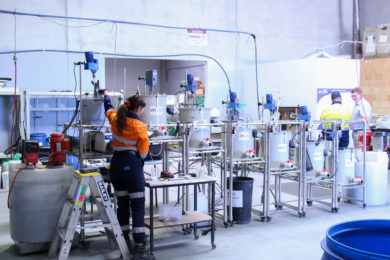Czech Republic-based Draslovka Holding is heading into a busy 12-month period where its glycine leaching technology will be showcased at numerous mining projects across the globe, the company told IM on the side lines of the Resourcing Tomorrow conference, in London, this week.
According to Ivor Bryan, Director of Mining Innovation at Draslovka Mining Solutions and the former MD of Mining & Process Solutions (MPS), the entity responsible for the development of the GlyCat™ and GlyLeach™ technologies, the company is embarking on around 10 projects in the mining space, which will prove up the 3,500 hours of testing that has been conducted at MPS’ facilities in Perth, Western Australia.
MPS was acquired by Draslovka, a major sodium cyanide producer in 2022, with the aim of the transaction being to grow and develop the glycine leaching business.
Gold leach testing via GlyCat has been the major area of focus over the last decade. The process was invented to reduce cyanide consumption while maintaining gold recovery for gold ores from deposits containing nuisance copper. It has been designed to enhance the dissolution of gold and copper in gold/copper ores where glycine is used as a catalyst with cyanide in a cyanide-starved leaching environment. It doesn’t replace cyanide, but, in fact, enhances its leaching capabilities by dealing with the high-cyanide consuming copper within these gold-copper orebodies.
Yet, the company is also now starting to make inroads into the base metal space through GlyLeach, with nickel and cobalt two specific areas of interest. The technology is able to leach the targeted metals with enhanced selectivity compared with conventional methods. It will solubilise copper, nickel, cobalt and zinc, while gangue minerals such as iron, manganese, silicates and carbonates remain in the leach residue, Draslovka says.
This is allowing the company to promote that it can reduce the capital expenditure associated with processing these metals by removing the need for smelting, or in the case of tailings deposits, helping recover metal from assets previously written off as ‘waste’.
While the technology could have applications at run of mine operations, Bryan and his colleague Jackson Briggs, Corporate Development Manager of Draslovka, believe the most immediate opportunity is in tailings where the application of glycine leaching on ‘waste’ material could recover valuable metals while reducing the potential liabilities associated with such storage facilities.
Of the 10 or so projects the company has ahead of it, one is situated in Western Australia where the company is looking to recover nickel and cobalt metals from a tailings deposit of a major mining company.
Another project – much closer to fruition – is in Chile and involves leaching a carbonate-hosted copper oxide deposit containing some 600 t of material.
In both cases, the company is looking to demonstrate that it can recover valuable metals at high recovery rates, with low impact – namely rationalising reagent and water use and, in the case of nickel-cobalt, removing smelting from the equation.
This, according to Draslovka CEO, Pavel Bruzek, is a “win-win” for mining companies and their stakeholders, benefitting both the balance sheet and the operational environmental footprint.
“While we are a major sodium cyanide producer, when we saw the potential of MPS’ glycine leaching technology and the increase in metallurgical complexity of orebodies looking to be exploited, it made perfect sense to work with and promote this technology,” he told IM. “It is the responsible thing to do for the industry.”










